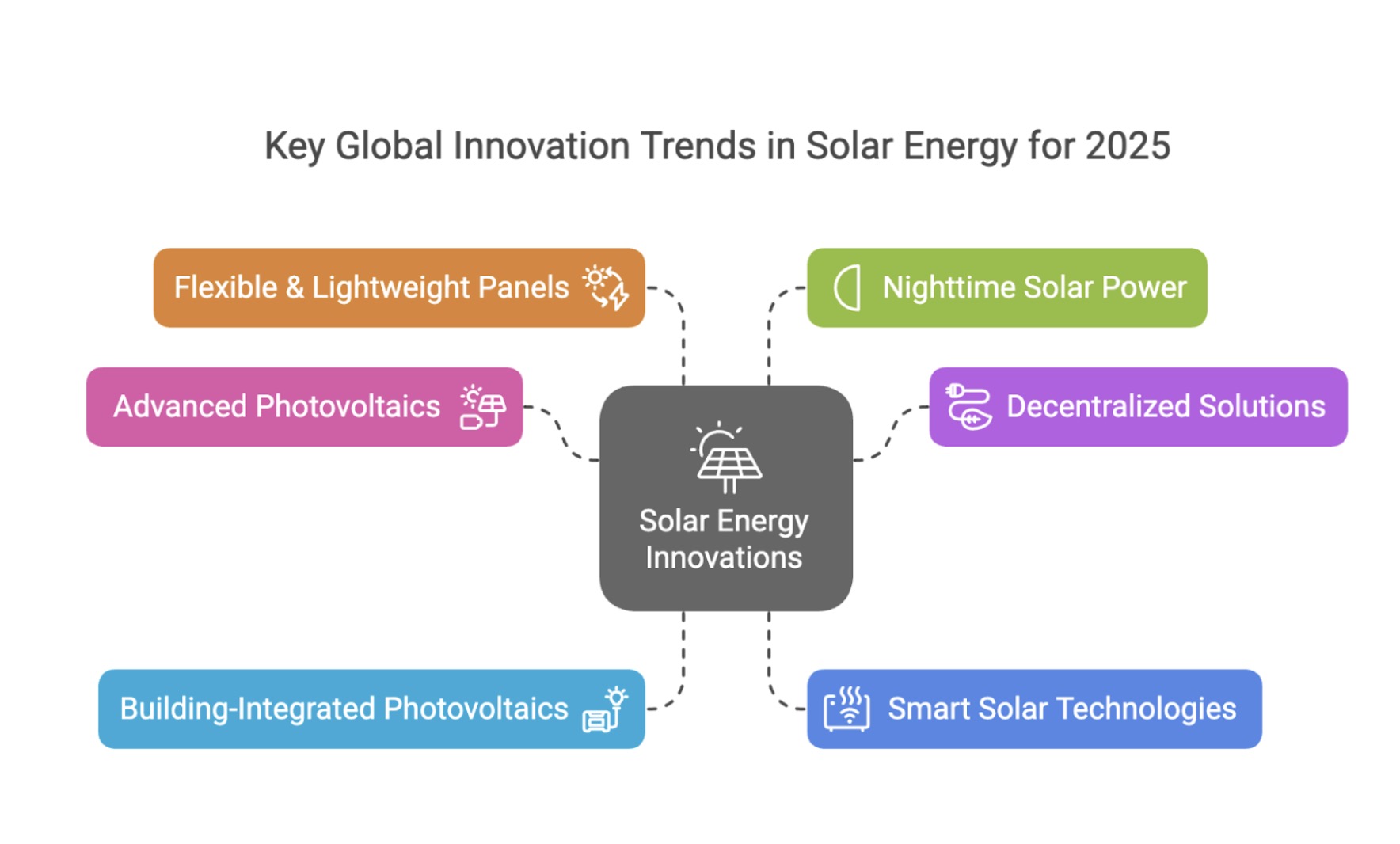
Key Global Innovation Trends in Solar Energy for 2025
Introduction: The Shifting Landscape of Solar Energy
The solar energy sector is undergoing a rapid transformation, driven by technological advancements, policy shifts, and evolving energy demands. Around the world, governments and industries are accelerating efforts to make solar power more efficient, accessible, and cost-effective. As innovation continues, we see two major forces shaping the future: headwinds—challenges like intermittency and supply chain dependencies, and tailwinds—breakthroughs in energy storage, photovoltaics, and decentralized solar solutions.
Globally, the focus is on enhancing efficiency, integrating smart technologies, and expanding the applications of solar power. Meanwhile, India is taking bold steps towards self-reliance in solar manufacturing, overcoming land constraints with innovative deployment methods, and investing heavily in energy storage. Let's explore the key trends defining the solar revolution in both the global and Indian contexts.

Key innovation trends shaping the future of solar energy
1. Advanced Photovoltaics: Boosting Efficiency and Performance
Perovskite Solar Cells: Emerging as a game-changer due to their high efficiency, lower production costs, and ability to absorb a broad spectrum of light. Research is focused on improving their stability and scalability, with tandem solar cells (perovskite + silicon) achieving record-breaking efficiencies.
Bifacial Solar Panels: These panels generate electricity from both the front and back, increasing energy output—especially valuable for floating solar farms.
Thin-Film Solar Panels: Lightweight and versatile, these panels (using cadmium telluride and amorphous silicon) enable integration into non-traditional surfaces like windows and roofs.
2. Enhanced Energy Storage Systems: Tackling Solar's Intermittency
Solar energy's biggest challenge has been its dependence on sunlight. The industry is addressing this with:
- Advanced battery technologies, including lithium-ion and flow batteries, with longer lifespans and higher energy densities.
- AI-driven battery management systems for smarter energy optimization and control.
3. Decentralized Solar Energy Solutions: Powering Remote & Resilient Grids
- Off-grid solar systems are becoming critical for energy access in remote areas.
- Solar microgrids offer reliable power to communities and critical facilities, especially during blackouts.
- Floating Solar Farms (Floatovoltaics) maximize space by using water bodies, reducing evaporation while generating power.
4. Building-Integrated Photovoltaics (BIPV): The Future of Urban Solar
- Solar Windows embed transparent solar cells, generating electricity while maintaining visibility.
- Solar Shingles & Tiles seamlessly replace traditional roofing materials, offering both shelter and energy production.
- Transparent Solar Panels allow light transmission, ideal for applications like greenhouses.
5. Smart Solar Technologies: AI & IoT Transforming Energy Management
- Real-time monitoring & predictive maintenance using IoT sensors.
- AI-driven solar grids optimize energy distribution based on weather patterns.
- Smart inverters enhance grid stability and energy management.
- Blockchain-based energy trading offers secure, decentralized transactions for peer-to-peer solar energy exchange.
6. Flexible & Lightweight Solar Panels: Expanding Solar's Reach
Innovations in materials are enabling solar panels that can be integrated into unconventional surfaces, including:
- Solar fabrics that can power wearables.
- Solar skin technology that blends solar panels with architectural aesthetics.
- Solar-powered electric vehicles (EVs) that self-charge for extended range.
7. Nighttime Solar Power: The Next Frontier
While still in early development, researchers are exploring ways to generate power at night by capturing radiation emitted from the Earth's surface—potentially overcoming solar's biggest limitation.
Related Articles
The India Story: A Market of Unique Challenges & Opportunities
India isn't just adopting solar innovation—it's redefining it. From agrivoltaics to floating solar...
The Future of Wind Energy: Technology, Policy, and Market Growth in 2025
From AI-powered turbines and digital twins to floating offshore farms and India's booming installations...
References
An Off-Grid Life. (2025). Solar power innovations. Retrieved from https://www.anoffgridlife.com/solar-power-innovations/
Energy Digital. (2025). Top 10 solar energy innovations. Retrieved from https://energydigital.com/top10/top-10-solar-energy-innovations
Global Society Earth. (2025). India's solar energy revolution: Innovations, challenges, and global impact. Retrieved from https://www.globalsociety.earth/post/india-s-solar-energy-revolution-innovations-challenges-and-global-impact
GreenLancer. (2025). Solar panel technology trends. Retrieved from https://www.greenlancer.com/post/solar-panel-technology-trends
Harvard Business School. (2025). IFC India 2025: Tata solar. Retrieved from https://www.hbs.edu/environment/blog/post/IFC-India-2025-Tata-solar
Manufacturing Today India. (2025). Powering India's solar revolution: Trends, challenges, and the roadmap to 2025. Retrieved from https://www.manufacturingtodayindia.com/powering-indias-solar-revolution-trends-challenges-and-the-roadmap-to-2025
New Day Solar. (2025). Innovative solar energy trends for 2025 and beyond: The future of solar technology. Retrieved from https://www.newdaysolar.com/innovative-solar-energy-trends-for-2025-and-beyond-the-future-of-solar-technology/
PV Magazine. (2025, March 21). Solar to take lead as India targets 500 GW of renewables by 2030. Retrieved from https://www.p v-magazine.com/2025/03/21/solar-to-take-lead-as-india-targets-500-gw-of-renewables-by-2030/
StartUs Insights. (2025). Solar energy trends. Retrieved from https://www.startus-insights.com/innovators-guide/solar-energy-trends/
TimesTech. (2025). Innovations driving India's solar energy revolution by 2025. Retrieved from https://timestech.in/innovations-driving-indias-solar-energy-revolution-by-2025/